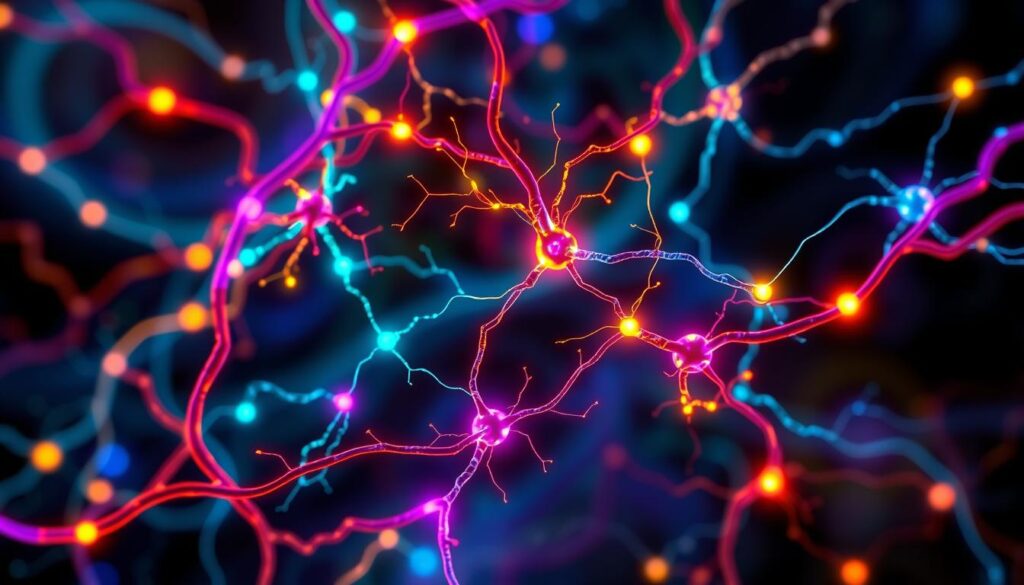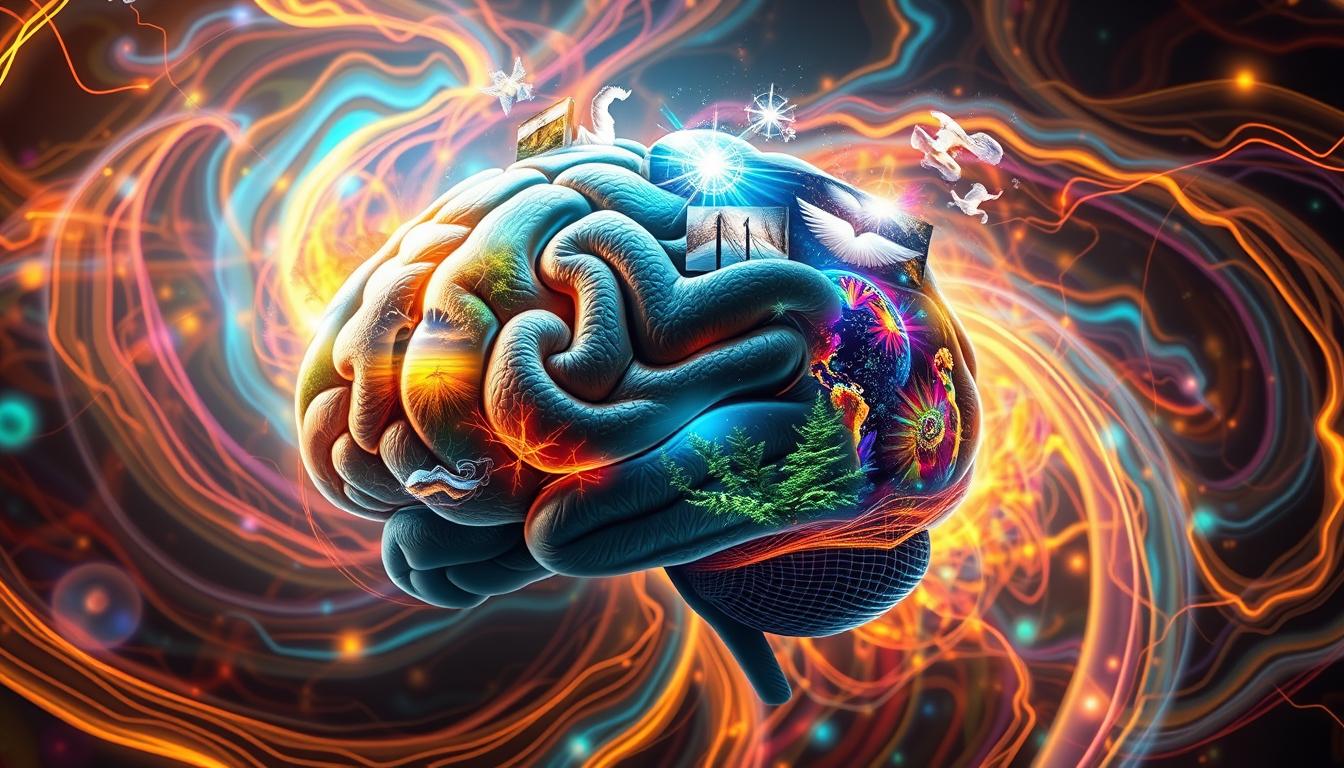“The power of imagination makes us infinite.” – John Muir
In today’s fast world, adapting and thriving is key. Visualization Techniques help tap into your brain’s ability to change. They can change your thoughts and unlock your potential.
Your brain is amazing, able to adapt and grow. Using mental imagery, you can shape your brain’s paths. This makes it easier to learn new things and succeed.
This guide will show you how to use visualization. You’ll learn to change your brain for the better. We’ll explore how to use mental rehearsal, change your thoughts, and more.
Key Takeaways
- Visualization taps into the brain’s neuroplasticity, enabling adaptability and growth.
- The brain cannot always distinguish between vividly imagined experiences and real ones, stimulating the same neural regions.
- Mental imagery and visualization can effectively shape neural pathways and promote desired behaviors.
- Practical applications of visualization techniques include reinforcing positive habits and achieving goals.
- Integrating mindfulness, neuro-linguistic programming, and self-hypnosis can enhance the power of visualization.
Understanding Brain Plasticity and Neural Rewiring
Discovering the power of neuroplasticity is key to unlocking your brain’s potential. This amazing ability lets your brain change and make new connections as you age. It shapes your thoughts, actions, and skills.
How Neuroplasticity Shapes Our Thoughts
When you try new things or face challenges, your brain gets stronger. It builds new paths and strengthens old ones. This is called cognitive restructuring. It helps you change your mind, learn new things, and break through mental barriers.
By imagining success, you use the same brain paths as if you were really doing it. This makes your brain more ready for success.
The Science Behind Mental Rehearsal
Studies show the brain’s amazing response to mental practice. fMRI scans show the brain lights up the same way for mental images as for real actions. This shows how mental imagery can change your brain.
Brain’s Adaptive Capabilities
Your brain is incredibly flexible and can change based on what you do and experience. From exercise to meditation, research shows many ways to improve your brain. It helps with thinking, healing, and making positive changes last.
| Neuroplasticity Enhancers | Key Findings |
|---|---|
| Physical Exercise | A 2018 review found that physical activity can promote neuroplasticity in various brain regions, benefiting memory, learning, and other cognitive functions. |
| Mindfulness Meditation | Studies suggest long-term meditation practice can alter brain function, enhancing focus, attention, and potentially safeguarding against cognitive decline. |
| Healthy Lifestyle | Research from 2017 highlights the importance of a balanced diet, adequate sleep, and an active lifestyle in supporting optimal brain function and neuroplasticity. |
| Learning New Skills | A 2021 study found that learning a new skill, such as Braille, can stimulate neuroplasticity and enhance its cognitive advantages. |
Tap into your brain’s amazing abilities and start a journey of self-discovery. By learning about neuroplasticity and using cognitive restructuring, you can change your brain for the better. This leads to lasting success and well-being.

The Power of Mental Imagery in Cognitive Restructuring
Using mental imagery is a powerful way to change your brain. It helps you see success and turn bad thoughts into good ones. This makes your mind ready for success.
Your brain sees mental imagery like real life. When you imagine doing something, your brain gets ready just like it would in real life. This makes you feel more ready to do it for real.
Cognitive restructuring uses mental imagery to change bad thoughts into good ones. By seeing yourself succeed and believing in yourself, you can change your mind. This helps you think more positively.
Studies show that thinking positively and using visualization can really help. It can make you less stressed, better at solving problems, and happier. People who want to do well and grow personally use their imagination to reach their goals.
Adding mental imagery to your daily life can change everything. Imagine yourself doing well, feeling good about yourself, or having a calm day. Your imagination is a strong tool for changing your mind and growing personally.
“The mind is everything. What you think, you become.” – Buddha

Let mental imagery change your life. Use your imagination to see the life you want. By changing your brain, you can boost your confidence and reach your full potential.
Visualization Techniques to Rewire the Brain
Unlocking your brain’s power is crucial for positive change. Guided Imagery, Mental Success Maps, and Sensory-Rich Visualization can change your thoughts and actions. They help rewire your brain.
Guided Imagery Exercises
Guided imagery uses vivid mental pictures to change your state. Imagine positive scenarios to activate your brain’s circuits. This helps create new patterns.
Find a quiet spot, close your eyes, and imagine a peaceful place. See yourself achieving your goals easily.
Creating Mental Success Maps
Mental Success Maps show your goals in detail. They include steps and emotional moments. Visualize each part of your journey.
Use all your senses to make it real. See colors, hear sounds, feel textures, and taste success. Look at your Mental Success Map often to strengthen your brain’s pathways.
Sensory-Rich Visualization Practice
Use as many senses as you can in your visualization. Imagine sights, sounds, smells, tastes, and feelings. The more vivid, the better it works.
Regular practice makes your dreams come true. It boosts your ability to achieve your goals.
Visualization unlocks your brain’s adaptability. Use it to shape your future. Practice regularly to align your brain with your goals.
Mindfulness Meditation and Brain Transformation
Mindfulness meditation is great for reducing stress and promoting relaxation. It uses guided imagery to help your brain manage stress better. By imagining peaceful scenes, your brain acts as if you’re really there, lowering stress and boosting well-being.
Regular mindfulness meditation can change your brain for the better. It improves emotional control and thinking skills. Studies show that 8 weeks of mindfulness training can grow the hippocampus, which helps with memory and emotions. It also shrinks the amygdala, which handles stress and fear.
You can start mindfulness practices like breathwork or journaling in just 5 minutes a day. These small habits can help rewire your brain, leading to more clarity and purpose.
“Mindfulness, characterized by full attention to present-moment experiences, induces structural changes in the brain linked to enhanced neuroplasticity.”
Mindfulness meditation does more than just reduce stress. It also improves attention, memory, and cognitive skills. It can even help with depression and anxiety, making it a valuable tool for mental health.
Adding mindfulness meditation to your daily routine can transform your brain. It helps you become more centered, focused, and resilient. Take the chance to rewire your brain and enjoy the deep benefits of Mindfulness Meditation.
Neuro-Linguistic Programming for Mental Rewiring
Discover the amazing power of Neuro-Linguistic Programming (NLP) to change your mind for good. This method, created in the 1970s by Richard Bandler and John Grinder, uses your brain’s ability to change. It helps you change your thoughts, feelings, and actions.
Language Patterns for Positive Change
NLP looks at how language affects your brain. By using certain words, you can change negative thoughts into positive ones. For example, saying positive things to yourself can make you more confident at work.
Anchoring Techniques
NLP’s anchoring helps you link good feelings to things around you. This way, you can easily feel good when you need it. It’s great for handling stress or bad thoughts.
Future Pacing Methods
NLP believes your brain can’t tell the difference between real and imagined experiences. By imagining success, you prepare your mind for it. This helps athletes and entrepreneurs reach their goals.
Using NLP can open up new possibilities in your life. It changes how you think, feel, and act. You can reach your highest potential with NLP’s language, anchoring, and visualization.
“Neuro-Linguistic Programming has provided me with the tools to reprogram my mind and achieve remarkable personal and professional growth.” – Successful Entrepreneur
Self-Hypnosis and Visualization Integration
Discover how to unlock your brain’s full power with self-hypnosis and visualization. These tools help you reach your subconscious mind. There, you can plant positive thoughts and change your behaviors and thoughts.
Research shows that over two-thirds of adults can be hypnotized. This shows how effective it is. Hypnosis can help with stress, trauma, depression, and pain. It makes certain parts of the brain work better, like emotion and memory.
Using self-hypnosis with visualization makes subconscious reprogramming even stronger. Methods like relaxation, vivid images, and positive sayings can change your brain. This leads to lasting positive changes.
Start using self-hypnosis and visualization integration to change your mind. Begin a journey of growth and empowerment. The possibilities are endless.
“Hypnosis induces deep relaxation, helping reduce stress and anxiety associated with stuttering, enabling individuals to approach speaking situations with more ease and confidence.”
Start unlocking your mind’s power today with subconscious reprogramming.
Practical Applications in Daily Life
Adding daily visualization to your routine can really improve your life. Start your day with a morning visualization routine to set a positive tone. It primes your brain for success. Imagine yourself achieving your goal achievement to stay motivated and focused.
For stress management, visualization is a great tool. It helps you cope with daily pressures and keeps your emotions balanced.
Morning Visualization Routines
Just 10-15 minutes each morning can change your day. Imagine feeling energized and confident. Visualize your ideal day, handling challenges with ease.
This mental rehearsal can make positive outcomes seem more real.
Goal Achievement Visualization
Visualizing your goals’ success is a strong technique for goal achievement. Close your eyes and vividly imagine enjoying your accomplishments. Use all your senses to make it real.
This strengthens the neural pathways for your desired outcomes. It boosts your motivation and focus.
Stress Management Techniques
When life gets tough, use visualization for stress management. Imagine a peaceful place that calms your mind and body. Breathe deeply and let worries fade away.
Regularly practicing these stress management techniques keeps your emotions balanced. It helps you make better decisions.
Using these daily visualization practices regularly can change your thoughts and behaviors. It empowers you to reach your goals and handle stress better.
“The power of visualization has helped me achieve the goal of living in Italy by July 1, well ahead of the set deadline.”
Overcoming Mental Blocks Through Visualization
Visualization is a strong tool for beating mental blocks and barriers. It helps you see yourself succeeding and solving problems. This way, you can get past doubts and negative thoughts.
Imagine yourself overcoming obstacles or talking to a smarter version of yourself. Or, picture yourself handling tough situations well. These visualization techniques can change how you think and feel about challenges.
Research shows that using your mind to practice can change your brain. It can help you learn new skills and do better in what you do. Studies with fMRI scans found that the brain acts the same when you imagine doing something as when you actually do it.
- Visualize breaking through physical barriers representing mental obstacles
- Imagine conversations with wiser versions of yourself for guidance and problem-solving
- Mentally rehearse challenging scenarios with positive outcomes
| Visualization Technique | Benefits |
|---|---|
| Breaking through mental barriers | Boosts confidence and problem-solving skills |
| Conversing with wiser versions of self | Provides guidance and perspective for overcoming obstacles |
| Mentally rehearsing positive scenarios | Primes the brain for successful outcomes |
By using these visualization techniques every day, you can change your brain. You’ll face challenges with more strength and creativity. This way, you can beat mental blocks and reach your goals.
Measuring Progress and Neural Changes
Tracking your progress in rewiring your brain is key to staying motivated. It helps you tweak your visualization practices for better results. You can measure progress in two ways: by how you feel and by what your brain does.
Subjective measures include how you feel and think. You might notice better moods and behaviors. Objective measures use tools like fMRI or EEG to see brain activity and structure changes.
Keeping a journal helps track your thoughts, emotions, and actions. It gives you insights into rewiring your brain. Regular checks keep you motivated and help adjust your routine.
As you keep practicing, you’ll see small changes in your brain. These changes lead to bigger, lasting improvements in your well-being.
The journey of rewiring your brain is ongoing. Every small step towards positive change matters. Celebrate your progress and trust in your brain’s ability to transform you into the best version of yourself.
FAQ
What is the role of neuroplasticity in brain rewiring?
Neuroplasticity lets the brain change and form new connections. It’s key for learning and changing habits. When we imagine doing something, our brain gets ready for it. This makes it easier to do it for real.
How does visualization impact the brain?
Visualizing an activity makes the brain act like it’s really happening. For example, an athlete’s brain gets ready to hit a tennis ball just by imagining it. This makes the real action feel more natural.
What are some practical visualization techniques for habit formation?
To form habits, define clear goals and create vivid mental images. Rehearse the process and repeat it often. The more detailed and emotional the images, the better.
How can mindfulness meditation and guided imagery help with brain transformation?
Mindfulness meditation reduces stress. Guided imagery uses peaceful scenes to calm the brain. Visualizing these scenes lowers stress and boosts well-being.
What are the key techniques in Neuro-Linguistic Programming (NLP) for mental rewiring?
NLP uses language and techniques like anchoring and future pacing. It changes negative thoughts into positive ones. Anchoring links desired states to triggers. Future pacing prepares for success.
How can self-hypnosis be integrated with visualization techniques?
Self-hypnosis and visualization together enhance rewiring. Hypnosis accesses the subconscious for positive changes. This combo deepens the rewiring of thoughts and behaviors.
How can visualization help overcome mental blocks and cognitive barriers?
Visualization helps overcome mental blocks by imagining success. It can involve breaking through barriers or solving problems mentally. This way, it bypasses self-doubt and negative thoughts.
How can progress in brain rewiring be measured?
Progress is measured through self-reporting and neuroimaging. Self-reporting tracks mood and behavior changes. Neuroimaging shows brain activity and structure changes. Keeping a journal helps track these changes.




























































